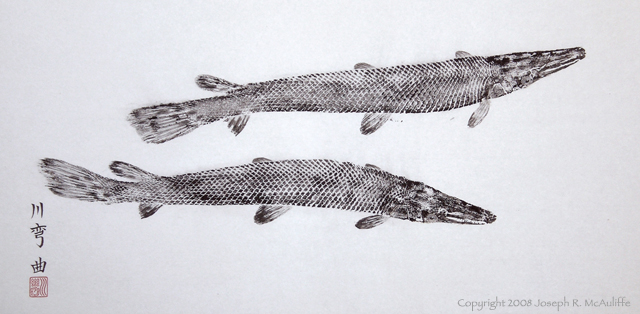
These are short-nosed gar (Lepisosteus platostomus). The scientific name “Lepisosteus” literally means “bony scale” and aptly describes the gar’s tough outer armor. Close-fitting, diamond-shaped plates called ganoid scales cover the entire body. An individual scale consists of a bony base, an even harder, thin layer of dentin, and a very hard, tooth enamel-like substance called ganoine on the surface. A peg-like extension in the leading edge of each scale’s bony base fits into a socket-like groove in the base of the adjacent scale, forming a hinge between the scales. Diagonal rows of the diamond-shaped, interlocking scales encase the entire body in a flexible, nearly impenetrable armor.
The gars are members of an ancient group of fish. Fossils of gars have been found in deposits 110 million years old, a time when dinosaurs roamed the earth. Complete fossils of gars from the 50 million year-old shales of the Green River Formation in Wyoming are so similar in appearance to modern-day gars that they are classified in the same genus, Lepisosteus. Well-preserved fossil gars have been found worldwide in North America, Europe, Africa, Madagascar, India, and South America, but are absent from eastern Asia. The current range of the several existing species of gars is limited to eastern North America, Mexico, Central America, and Cuba. Although gars are “primitive” in their origin and body form, their abundance and success through the long expanse of geologic time is testimony of their endurance and success.
This gyotaku composition differs from most in that it provides an oblique view of the fish from above. Bodies of most kinds of fish are laterally compressed, suiting one side or the other for printing. The cylindrical body of a gar, however, makes it as easy (or difficult!) to print the dorsal (back) or ventral (belly) surfaces as it is to print only the sides. To make this impression, the gar was positioned on its belly and ink was applied to the upper part of one side and over the back, slightly down the other side. The top of the head and upper part of one side, including an eye, were likewise inked. Black ink on white paper was used in order to accentuate the arrays of diamond-shaped ganoid scales. The fins were removed and portions of them were printed separately to give the perspective of a view from above. This oblique view captures the spirit of the many gar I have seen as they slowly swam by, just beneath the water surface in slow-moving rivers and oxbows of eastern Nebraska.
Size: 36 x 20 inches (2004)
Return to Gallery 2.